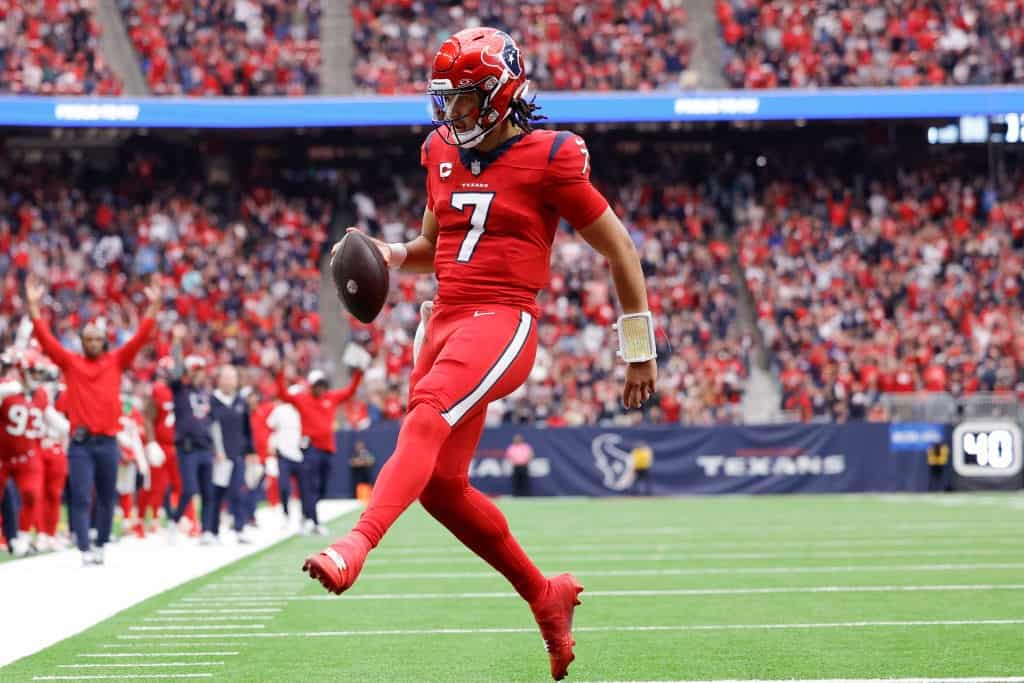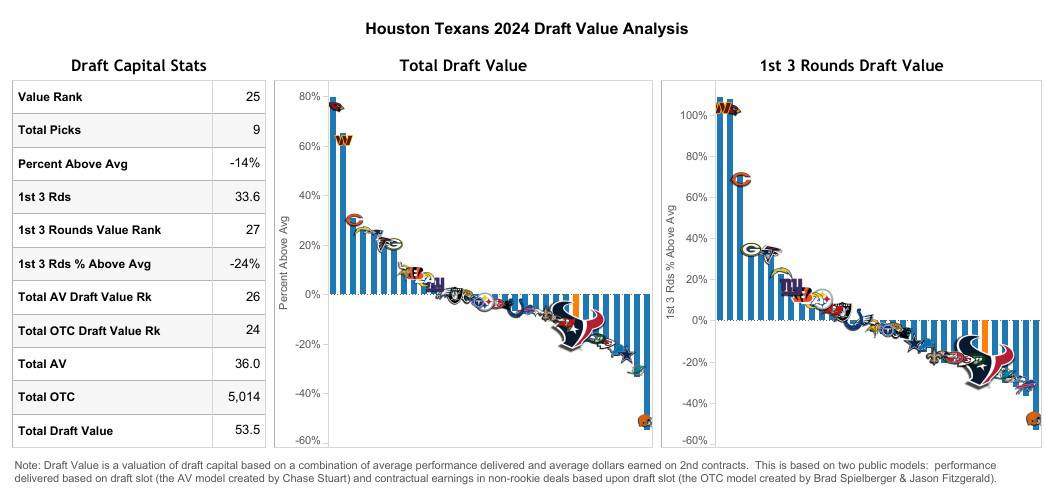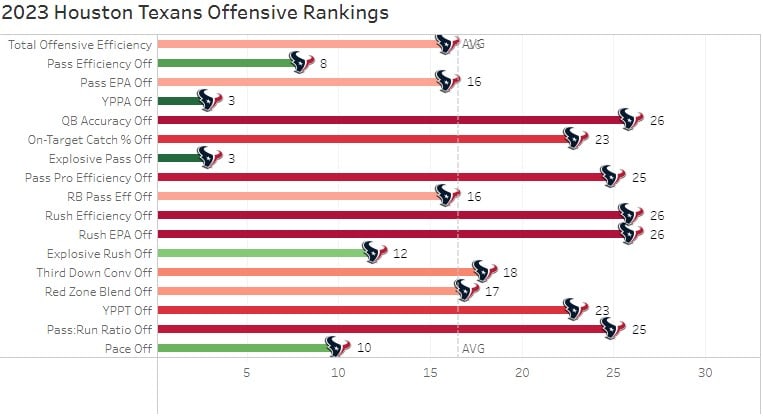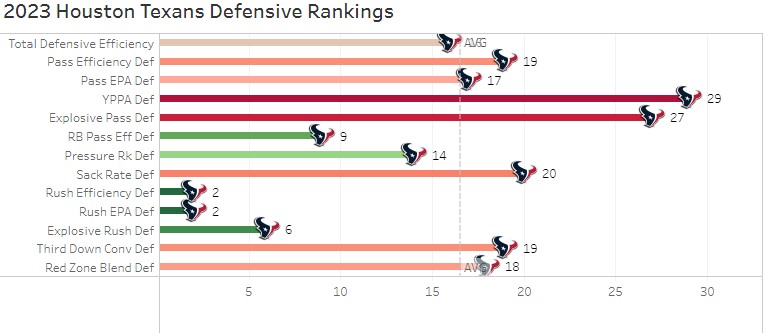As a lead-up to the 2024 NFL draft, we’ve broken down the current depth chart of every NFL team and identified the biggest draft and team needs for the Houston Texans.
You can find additional team-by-team draft needs articles and other draft content on our 2024 NFL Draft Hub.
Houston Texans Needs: Top Positions of Need in 2024
- Defensive Back
- Defensive Line
- Defensive Depth
What Picks Do the Houston Texans Have in 2024?
The Houston Texans have 9 picks in the 2024 NFL Draft, including:
- Round 2 (42)
- Round 2 (59)
- Round 3 (86)
- Round 4 (123)
- Round 4 (127)
- Round 6 (188)
- Round 6 (189)
- Round 7 (238)
- Round 7 (247)
Pre Order the Best Analytical 2024 Football Preview
Don’t miss out on Warren Sharp’s 500+ page preview of the 2024 NFL season.
The preview is unlike anything you have ever seen, featuring stunning visualizations built with the reader in mind.
This preview shares insights into players, coaches, teams, and philosophies with one goal in mind: to prepare you for the 2024 NFL season by delivering the smartest information in the fastest, most direct way possible.
Pre order the 2024 Football Preview now!
Houston Texans Draft Capital Stats
Our Sharp Draft Value Rank is a valuation of draft capital based on a combination of average performance delivered and average dollars earned on second contracts.
This is based on two public models: performance delivered based on draft slot (the AV model created by Chase Stuart) and contractual earnings in non-rookie deals based upon draft slot (the OTC model created by Brad Spielberger and Jason Fitzgerald).
- Texans Sharp Draft Value Rank: 25 of 32 teams
- Texans AV Model Draft Value Rank: 26 of 32 teams
- Texans OTC Model Draft Value Rank: 24 of 32 teams
Houston Texans Draft Value vs. Other Teams:
The Texans’ draft value is 14% lower than the league average of all 32 teams. 24 other teams have more draft value entering the 2024 NFL Draft.
Houston Texans Draft Prediction:
Mock draft expert Ryan McCrystal believes the Texans could target a defensive lineman like Braden Fiske (DL, Florida State) with their top pick at No. 42 overall in the second round.
Houston Texans Strength of Schedule, 2024
The Houston Texans have the 7th-hardest NFL strength of schedule for the 2024 NFL season.
Houston Texans Offense: Depth Chart, Analysis & Draft Needs
Rich Hribar breaks down the offensive depth chart by position for the Houston Texans, identifying areas where the team could improve in the upcoming 2024 NFL Draft.
Quarterback Depth Chart, Texans:
- C.J. Stroud
- Davis Mills
- Case Keenum
- Tim Boyle
Houston hit the jackpot last spring by landing C.J. Stroud at No. 2 overall.
Not only did Stroud have a great season in the context of rookie quarterbacks, but he had a great season in the context of all quarterbacks in the league in 2023.
Stroud threw for 8.2 yards per pass attempt (third in the NFL) with a league-best 4.6 TD-to-INT ratio.
He finished sixth in the league in EPA per dropback (0.11) and ninth in success rate (45.5%).
Layering in all the injuries that Houston dealt with on their offensive line and at wide receiver, the 2023 season for Stroud was nothing short of a major win for the organization.
We have seen the organization embrace that this offseason, aggressively looking to add talent to the roster and make a larger push while Stroud is on his rookie contract.
Running Back Depth Chart, Texans:
- Joe Mixon
- Dameon Pierce
- J.J. Taylor
- Gerrid Doaks
- Andrew Beck (FB)
- Troy Hairston (FB)
The Houston run game had some moments of success, but overall this was a primary area of weakness for the offense.
Houston running backs closed the 2023 season ranking:
- 26th in yards per carry (3.7 YPC)
- 26th in EPA per rush (-0.14)
- 29th in success rate (31.7%)
- 18th in the rate of runs to gain 10 or more yards (9.2%)
- 27th in the rate of runs that failed to gain yardage (20.1%)
- 31st in the rate of runs to result in a first down or touchdown (16.1%)
- 24th in yards before contact per rush (1.06)
- 29th in yards after contact per rush (2.57)
The injuries to the offensive line did not aid the cause, but Houston made it a focal point to upgrade the position since Bobby Slowik stems from a coaching tree that values running the football effectively.
After failing to land Saquon Barkley, Houston pivoted by trading for Joe Mixon and then giving him a three-year contract.
Mixon has left meat on the bone for his career as a runner, but he is a reliable workhorse back.
Turning 28 this summer, Mixon has posted over 1,200 total yards in five of the past six seasons.
Mixon has 37 total touchdowns over the past three years.
Last season with Cincinnati, Mixon led all running backs with 80.8% of his backfield rushes while accounting for a league-high 78.8% of the backfield touches overall.
While Mixon has accumulated counting stats playing in good offenses (something he has in place again here), his peripheral metrics have not been as strong.
Even last season, his underlying metrics look similar to what Houston got out of Devin Singletary.
2023 Joe Mixon vs Devin Singletary:
| 2023 | YPC | EPA/Rush | Success% | Explosive% | Stuff% | YAC/Att |
|---|---|---|---|---|---|---|
| Mixon | 4.0 | -0.06 | 36.6% | 10.5% | 16.0% | 2.51 |
| Singletary | 4.2 | -0.07 | 35.6% | 10.6% | 16.2% | 2.85 |
Mixon also had those stats running into light boxes on 35.4% of his carries while Singletary only ran into light fronts on 26.4% of his runs.
That last component is an intriguing element of this transition for Mixon.
He has been a back that has steadily run out of shotgun against light boxes under Zac Taylor.
Since he entered the NFL, 30.2% of Mixon’s runs have come against light boxes.
James Conner is the only running back with a higher rate over that span who has as many rushes as Mixon.
Houston will certainly run 11 personnel at a higher rate this season based on the quality of the wide receiver room, but Mixon will have more runs with a fullback on the field than ever before.
Mixon has just 20 career runs with another back on the field.
Houston was fifth in the NFL last season in runs with a fullback on the field (198).
Under Slowik, Houston was fourth in the NFL in run rate from 21 personnel (28.7%).
We should expect more 3WR sets from Houston this season, but Slowik is not going to scrap the fullback from the run game.
Behind Mixon, Dameon Pierce completely flatlined last season.
He was so bad in his second season that the team aggressively moved on from him in season and turned to Singeltary full-time.
Pierce struggled with the scheme change, finishing last among all backs with 100 or more rushes in yards per carry (2.9) and success rate (23.4%).
Pierce is the only other back outside of Mixon on this roster signed beyond 2024, which includes both fullbacks.
Wide Receiver Depth Chart, Texans:
- Stefon Diggs
- Nico Collins
- Tank Dell
- Robert Woods
- Noah Brown
- John Metchie
- Xavier Hutchinson
- Steven Sims
- Johnny Johnson
- Jared Wayne
You can make a strong case that Houston has the best wide receiver room now in the NFL.
Not only in terms of potential WR1-WR3 but having guys like Robert Woods and Noah Brown as your WR4 and WR5 is a spot most of the league would like to be in.
Of course, it all starts at the top with Stefon Diggs, Nico Collins, and Tank Dell.
Collins made a major jump in year three, catching 80 passes for 1,297 yards and eight touchdowns over 15 games in the regular season.
Collins was second in the league behind Tyreek Hill in yards per route run last season (3.11).
The quality of targets was the largest difference.
After 25.8% of his targets were inaccurate in 2022, that off-target rate dropped to 13.8% last season.
The breakout season for Collins came at the right time, as he enters the final season of his rookie contract this season.
Dell was third among all rookie wide receivers in yards per route run (2.22), trailing only Puka Nacua (2.60) and Rashee Rice (2.41).
He ranked fifth among all rookie wideouts in target rate per route run (23.5%) and fourth in the rate of targets to result in a first down or touchdown (45.3%).
Both Dell and Collins had bumps during moments when the other player missed time, but on 210 passing plays with both players on the field at the same time, Collins averaged 2.88 yards per route run and Dell averaged 2.26 yards per route.
When both players were on the field, they combined for 49.7% of the team targets. The next closest player on the team had 15.8% of the targets.
That is surely going to change with the arrival of Diggs.
Diggs started 2023 on fire.
He went over 100 yards in five of his first six games of the season.
Then the bottom fell out, and he never had another 100-yard game.
Over the final 13 games of the season, he had fewer receiving yards than Khalil Shakir, who had 59 fewer targets over that span than Diggs.
We expect a player as good as Diggs to produce at a higher level than he did to close the season.
Bar none, he is the first finger to point in his decline.
But there were several other contributing factors such as an offensive coordinator change, a reduction in his depth of the target, and the Bills facing a rogue’s gallery of defenses that were good against the pass last season.
Over that same span, Josh Allen was 15th in completion rate, 18th in yards per pass attempt, and 13th in accuracy rating.
Regardless of how his 2023 season ended, Diggs still commanded a high rate of targets.
He was targeted on 27.0% of his routes, which was 12th among wide receivers.
It will be interesting to see how the targets shake out here, but the addition of Diggs gives Houston the best WR1-WR3 punch in the league.
Despite being flush with options in 2024, Houston only has Dell signed beyond this season out of the core receivers.
The only other wideouts who are signed past 2024 are John Metchie and Xavier Hutchinson.
It is doubtful that Houston aggressively chase a wide receiver in this draft, but the overall strength of this depth chart is going to be hard to keep together beyond 2024.
Tight End Depth Chart, Texans:
- Dalton Schultz
- Brevin Jordan
- Teagan Quitoriano
- Dalton Keene
Houston brought back Dalton Schultz on a three-year deal after he caught 59 passes for 635 yards and five touchdowns.
Schultz ranked 13th among tight ends in target rate per route (20.4%), which dipped to 18.8% when both Nico Collins and Tank Dell were on the field.
He could see his targets dip further with the addition of Stefon Diggs, but where Schultz made his largest impact was near the end zone.
He had 19.1% of the team targets in the red zone (TE9) and 22.0% of the team targets thrown into the end zone (TE6).
Behind Schultz, the team has Brevin Jordan in the final season of his rookie contract while Teagan Quitoriano is signed through 2025.
Offensive Line Depth Chart, Texans:
LT: Laremy Tunsil, David Sharpe
LG: Kenyon Green, Kendrick Green
C: Juice Scruggs, Jarrett Patterson, Jaylon Thomas
RG: Shaq Mason, Nick Broeker, Dieter Eiselen
RT: Tytus Howard, Charlie Heck, Kilian Zierer
This unit was completely ravaged by injuries in 2023.
Houston’s most frequently used offensive line combination last season was on the field for 20.2% of their offensive snaps, which was 28th in the league.
Shaq Mason was the only lineman to play in all 17 regular-season games.
Only three other players played in 10 or more games. Of those three, Laremy Tunsil is the only one currently on the roster.
2022 first-round pick Kenyon Green missed the entire season with a shoulder injury that he suffered in the final preseason game.
His backup Kendrick Green only played three games.
Tytus Howard only appeared in seven games.
The team selected Juice Scruggs in the second round last season. He didn’t play until Week 12 due to a hamstring injury in the preseason.
Just running into a better fortune in keeping their players healthier this season will go a long way in this unit playing better in 2024.
Tunsil, Howard, and Mason are all signed through 2026, and both Green and Scruggs have multiple remaining on their rookie deals.
Houston Texans Defense: Depth Chart, Analysis & Draft Needs
Raymond Summerlin breaks down the defensive depth chart by position for the Houston Texans, identifying areas where the team could improve in the upcoming 2024 NFL Draft.
Defensive Line Depth Chart, Texans:
- Denico Autry
- Foley Fatukasi
- Khalil Davis
- Tim Settle
- Mario Edwards
- Kurt Hinish
- McTelvin Agim
The Texans allowed 3.3 yards per running back carry (1st) and finished 2nd in yards before contract allowed per RB run last season.
Unfortunately, the defensive line that helped secure those numbers is mostly gone.
Denico Autry, Foley Fatukasi, Tim Settle, and Mario Edwards are all new additions.
Autry is the big name among that group, coming over after three seasons with the division-rival Titans.
He is heading into his age-34 season, but he should be able to provide consistent pressure from the inside, assuming that’s where the Texans plan to use him.
Autry finished last season with 11.5 sacks with an 11.3% pressure rate. He logged pressure on 12.9% of his pass rush snaps in Tennessee.
He should be a good replacement for Sheldon Rankins.
Foley Fatukasi joined from the Jaguars, where he spent two seasons.
Fatukasi was very productive against the run with the Jets, but he did not really recreate that during his time in Jacksonville.
He should fill a rotational role.
Tim Settle is also likely to be a rotational option against the run after getting pressure on just 5.8% of his pass rush snaps over the last two seasons with the Bills.
Mario Edwards will likely focus more on the pass rushing side. He had 2 sacks with a 10.4% pressure rate with the Seahawks last season.
Among the returners, Khalil Davis proved to be a solid option after bouncing around the league at the start of his career.
He finished with 2 sacks on an 8.9% pressure rate and logged a run stuff on 5% of his run defense snaps.
Davis could end up being a good find by this front office.
The Texans added enough here that they can likely get by this season, although a real starter would be a boost.
The real concern is moving forward with Fatukasi, Edwards, Settle, and Davis all free agents after this season.
EDGE Depth Chart, Texans:
- Danielle Hunter
- Will Anderson Jr.
- Derek Barnett
- Dylan Horton
- Marcus Haynes
- Ali Gaye
Houston finished 13th in pressure rate and logged 46 sacks (13th) last season.
There were not as many changes to this unit as at defensive line, but the top of the depth chart does look different.
With Jonathan Greenard leaving for the Vikings, the Texans brought in ex-Viking Danielle Hunter to play opposite Will Anderson Jr.
Hunter is coming off a 16.5-sack season with the Vikings. He logged pressure on 13.4% of his pass rush snaps, which is not elite but was better than Greenard a season ago.
Will Anderson is back after winning Defensive Rookie of the Year last season.
Anderson was second on the team with 7 sacks last year, but his 15.8% pressure rate was 21st among all eligible pass rushers.
Anderson finished 3rd among edge rushers in ESPN’s pass rush win rate metric.
Derek Barnett was claimed off waivers late in the season and immediately became an impact pass rusher.
He had 2.5 sacks in six games with a 17.5% pressure rate.
A fourth-round pick last year, Dylan Horton had to step away from the team after being diagnosed with Hodgkin’s lymphoma.
He recently announced he is in remission, which is the only news that really matters, but it remains unclear when or if he will be able to play again.
Horton’s situation creates some depth concerns, and Barnett is heading into a contract year.
Linebacker Depth Chart, Texans:
- Azeez Al-Shaair
- Christian Harris
- Henry To’oTo’o
- Del’Shawn Phillips
- Neville Hewitt
- Jake Hansen
Linebacker is another position with turnover at the top of the depth chart.
Both Denzel Perryman and Blake Cashman are gone, replaced by Azeez Al-Shaair.
Al-Shaair played last season with the Titans, but he was with HC DeMeco Ryans in San Francisco.
He was hyperproductive in the running game last season, forcing 17 run stuffs and logging a tackle on 25.9% of his run defense snaps.
Christian Harris does return after playing 755 snaps last season.
The 2022 third-round pick took a big step forward in his second season, especially in coverage.
He finished 24th among qualifying linebackers with 6.5 yards allowed per target.
A fifth-round pick last year, Henry To’oTo’o struggled as a rookie, and the players behind him are more special teams options.
This is not a pressing need because the top two are solid, but the Texans could use some depth here.
Cornerback Depth Chart, Texans:
- Derek Stingley Jr.
- Jeff Okudah
- Desmond King II
- C.J. Henderson
- Mike Ford
- Myles Bryant
- Kris Boyd
- Troy Pride
- D’Angelo Ross
The Texans allowed 7.7 yards per pass attempt (29th) and finished 19th in EPA per dropback in 2023.
Derek Stingley Jr. emerged as a high-end coverage option in his second season, although he once again failed to play the full year.
Stingley was limited to 11 games in the regular season, but he allowed just a 76.6 passer rating in coverage.
PFF credited him with a forced incompletion on 20.8% of his targets, the sixth-highest rate among qualified corners.
With Steven Nelson still unsigned, the Texans need to find someone to play opposite Stingley, and they added two former first rounders looking to turn around their career.
Jeff Okudah was the No. 3 overall pick of the 2020 draft, but he did not have a good season with the Falcons last year.
C.J. Henderson was the No. 9 overall pick of the same draft, and he also struggled last season with the Panthers.
Picked up in the middle of the season, Desmond King played well as the slot option late in the year, allowing 5.9 yards per target.
Perhaps the Texans will just gamble on one of the former first rounders stepping up, but that No. 2 corner spot looks like a need.
Safety Depth Chart, Texans:
- Jalen Pitre
- Jimmie Ward
- Eric Murray
- M.J. Stewart
- Lonnie Johnson Jr.
- Brandon Hill
This is a position group full of questions.
A 2022 second-round pick, Jalen Pitre has not been terrible starting 32 games over his first two seasons, but he also has not really stood out.
A step forward from him in year three would be a big boost.
Even if he does, though, the second safety spot remains up in the air.
Jimmie Ward played 10 games last season, will be 33 in July, and has a long injury history.
Eric Murray played six games last season and was not really a factor on defense in 2022.
M.J. Stewart played eight games last season and also has been a bigger factor on special teams.
Lonnie Johnson Jr. is back after two seasons away, but his last run with the Texans was not great.
This sticks out as a place where the Texans could really use a high-end starter.
Pre Order the Best Analytical 2024 Football Preview
Don’t miss out on Warren Sharp’s 500+ page preview of the 2024 NFL season.
The preview is unlike anything you have ever seen, featuring stunning visualizations built with the reader in mind.
This preview shares insights into players, coaches, teams, and philosophies with one goal in mind: to prepare you for the 2024 NFL season by delivering the smartest information in the fastest, most direct way possible.





















